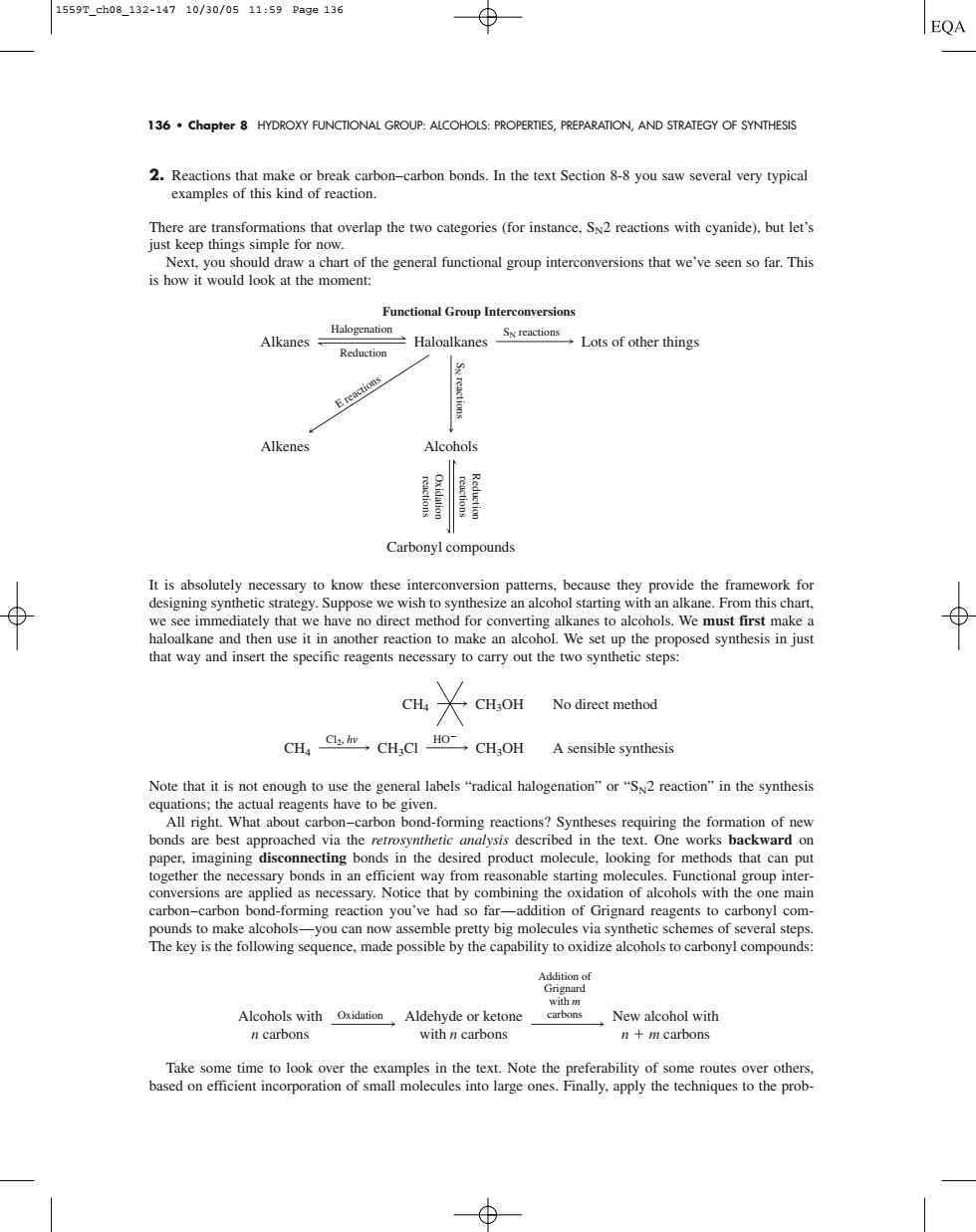正在加载图片...

1559T_ch08_132-14710/30/0511:59Pa9e136 ⊕ EQA 136.Chapter 8 HYDROXY FUNCTIONAL GROUP:ALCOHOLS:PROPERTIES,PREPARATION,AND STRATEGY OF SYNTHESIS 2.Reac carbon-carbon bonds.In the text Section8 you saw several very typical Next,you sh ould draw a chart of the general functional group interconversions that we've seen so far.This is how it would look at the moment: Functional Group Interconversion Haloalkanes Lots of other things Carbonyl compounds we see immediately thate have no direct method for alkanes to alcohols.We must first make CH3OH No direct method Note that it is not enough to use the general labels"radical halogenation"or"S2 reaction"in the synthesis have o e given paper,imagining disconneeting bonds in the desired product molecule.looking for methods that can put carbon-carbon bond-f orming reaction you've had so far-addition of Grignard reagents to carbonyl com- es of ev Alcohols with Oxidation Aldehyde or ketone New alcohol with n carbons with n carbons n+m carbons 136 • Chapter 8 HYDROXY FUNCTIONAL GROUP: ALCOHOLS: PROPERTIES, PREPARATION, AND STRATEGY OF SYNTHESIS 2. Reactions that make or break carbon–carbon bonds. In the text Section 8-8 you saw several very typical examples of this kind of reaction. There are transformations that overlap the two categories (for instance, SN2 reactions with cyanide), but let’s just keep things simple for now. Next, you should draw a chart of the general functional group interconversions that we’ve seen so far. This is how it would look at the moment: It is absolutely necessary to know these interconversion patterns, because they provide the framework for designing synthetic strategy. Suppose we wish to synthesize an alcohol starting with an alkane. From this chart, we see immediately that we have no direct method for converting alkanes to alcohols. We must first make a haloalkane and then use it in another reaction to make an alcohol. We set up the proposed synthesis in just that way and insert the specific reagents necessary to carry out the two synthetic steps: Note that it is not enough to use the general labels “radical halogenation” or “SN2 reaction” in the synthesis equations; the actual reagents have to be given. All right. What about carbon–carbon bond-forming reactions? Syntheses requiring the formation of new bonds are best approached via the retrosynthetic analysis described in the text. One works backward on paper, imagining disconnecting bonds in the desired product molecule, looking for methods that can put together the necessary bonds in an efficient way from reasonable starting molecules. Functional group interconversions are applied as necessary. Notice that by combining the oxidation of alcohols with the one main carbon–carbon bond-forming reaction you’ve had so far—addition of Grignard reagents to carbonyl compounds to make alcohols—you can now assemble pretty big molecules via synthetic schemes of several steps. The key is the following sequence, made possible by the capability to oxidize alcohols to carbonyl compounds: Take some time to look over the examples in the text. Note the preferability of some routes over others, based on efficient incorporation of small molecules into large ones. Finally, apply the techniques to the probOxidation Addition of Grignard with m Alcohols with carbons n carbons Aldehyde or ketone with n carbons New alcohol with n m carbons CH4 Cl2, hv HO CH4 CH3OH CH3Cl CH3OH No direct method A sensible synthesis Alkanes Haloalkanes Alcohols Carbonyl compounds Lots of other things Halogenation Reduction SN reactions SN reactions Alkenes E reactions Reduction reactions Oxidation reactions Functional Group Interconversions 1559T_ch08_132-147 10/30/05 11:59 Page 136�